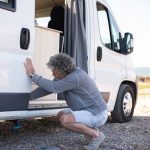Male Vandergrift
Family-Friendly Activities at Smoky Mountain RV Campgrounds
Family-Friendly Activities at Smoky Mountain RV Campgrounds
The Smoky Mountains offer a stunning backdrop for a memorable family vacation. 🏞️ Whether you’re an adventurous family looking to explore the great outdoors or prefer relaxing activities that bring everyone together, the Smoky Mountain RV campgrounds have something for everyone. Let’s dive into some family-friendly activities that will make your trip unforgettable!
Table of Contents
1. Exploring Nature Trails 🌲
2. Campground Games and Activities 🎲
3. Fishing and Water Adventures 🎣
4. Evening Campfire Fun 🔥
5. Local Attractions and Day Trips 🚗
Exploring Nature Trails 🌲
One of the best ways to enjoy the Smoky Mountains is by exploring their beautiful nature trails. With trails ranging from easy to challenging, there’s a perfect path for every family. The trails offer a great opportunity to teach kids about native plants and wildlife. Don’t forget to bring a camera 📸 to capture those breathtaking views and memorable family moments.
Campground Games and Activities 🎲
Many RV campgrounds in the Smokies offer a variety of games and activities to keep the entire family entertained. From playgrounds and basketball courts to organized activities like scavenger hunts and arts and crafts, there’s never a dull moment. Encourage your kids to make new friends while you enjoy some downtime with a good book or a leisurely walk.
Fishing and Water Adventures 🎣
If your family loves water activities, you’re in luck! The Smoky Mountain campgrounds often feature accessible fishing spots where you can try your luck at catching trout or bass. For those who prefer a bit more excitement, consider renting kayaks or canoes for a day of paddling on the nearby lakes or rivers. Remember, safety first—always wear life jackets and stay aware of weather conditions.
Evening Campfire Fun 🔥
No camping trip is complete without a cozy evening around the campfire. Share stories, roast marshmallows, and enjoy the warmth of the fire under the starry sky. 🌟 Many campgrounds host scheduled campfire events where you can join other families for songs and stories, making it a perfect way to end your day.
Local Attractions and Day Trips 🚗
The Smoky Mountains are surrounded by charming towns and attractions worth exploring. Consider a day trip to Gatlinburg for the aquarium or visit the nearby Dollywood for some theme park fun. These excursions provide a break from the campsite and add a dash of variety to your vacation.
Conclusion
The Smoky Mountain RV campgrounds are a treasure trove of family-friendly activities. From hiking and fishing to campfire stories and local adventures, there’s something for everyone in your family to enjoy. Whether you’re creating lifelong memories or just enjoying a peaceful retreat, the Smoky Mountains offer a perfect setting for families to connect and explore together.
FAQ
1. What should we pack for a family trip to a Smoky Mountain RV campground?
Pack essentials like sturdy hiking boots, warm clothing for cooler evenings, fishing gear if you plan to fish, and any personal items your family may need. Don’t forget marshmallows for the campfire! 😊
2. Are the trails suitable for children?
Yes, many trails are family-friendly and suitable for children. It’s best to research trails in advance to choose ones that match your family’s fitness level and interests.
3. Can we rent fishing equipment at the campgrounds?
Some campgrounds offer fishing gear rentals, but it’s a good idea to call ahead and confirm what’s available. Alternatively, you can bring your own gear for convenience.
4. Are pets allowed at the campgrounds?
Pet policies vary by campground. It’s essential to check in advance if pets are allowed and what rules apply to ensure a comfortable stay for everyone.
5. What local attractions are a must-visit?
Gatlinburg and Pigeon Forge are popular nearby destinations with plenty of attractions, including the Great Smoky Mountains National Park and Dollywood. Each offers unique experiences that are perfect for families.
When to Opt for Mobile RV Repair: Key Indicators
When to Opt for Mobile RV Repair: Key Indicators
Exploring the open road in your RV is exhilarating, but encountering unexpected issues can put a damper on your adventure. Knowing when to call for mobile RV repair can save you time, money, and stress. In this blog post, we’ll explore the key indicators that suggest it’s time to opt for mobile RV repair services 🚐🔧.
Table of Contents
- Immediate Attention Required 🚨
- Convenience Overhaul 🕒
- Specialized Needs 🛠️
- Roadside Assistance Limitations 🚧
- Conclusion: Keep the Adventure Rolling
- FAQ: Your Questions Answered
Immediate Attention Required 🚨
Imagine cruising down the highway when suddenly, your RV’s engine starts sputtering or the brakes feel unresponsive. These urgent issues require immediate attention. Mobile RV repair services can provide emergency assistance right where you are, getting you back on the road swiftly and safely.
Convenience Overhaul 🕒
Let’s face it, the logistics of driving a massive RV to a repair shop can be daunting. Mobile RV repair services come to you, offering unparalleled convenience. Whether you’re parked at a campsite or your driveway, you can relax while professionals handle the repairs on-site, saving you precious time and effort.
Specialized Needs 🛠️
RVs are complex machines with unique systems that require specialized knowledge. Mobile RV technicians often have the expertise and parts necessary for RV-specific repairs, from electrical systems to plumbing. This specialized attention ensures that your RV is serviced correctly, maintaining its performance and safety.
Roadside Assistance Limitations 🚧
While roadside assistance is invaluable for minor issues like flat tires or battery jumps, it may not cover extensive repairs. Mobile RV repair services fill this gap, providing comprehensive solutions for more significant problems that require professional attention beyond the scope of typical roadside assistance.
Conclusion: Keep the Adventure Rolling
Knowing when to opt for mobile RV repair can make all the difference in your travel experience. By recognizing these key indicators, you can address issues promptly, ensuring a smoother journey. So, next time your RV acts up, consider mobile repair services to help keep your adventure rolling smoothly and worry-free 🌟.
FAQ: Your Questions Answered
What types of repairs do mobile RV services typically handle?
Mobile RV repair services can handle a wide range of issues, including engine problems, brake repairs, electrical and plumbing system maintenance, and more. Their expertise often extends to RV-specific needs.
How quickly can mobile RV repair services reach me?
Response times can vary based on your location and the availability of technicians. However, many services aim to reach you quickly, especially in emergency situations.
Are mobile RV repair services more expensive than traditional shops?
While the convenience might suggest higher costs, mobile RV repair services often offer competitive pricing. Plus, the time and hassle saved by not having to drive your RV to a shop can be invaluable.
Can mobile RV repair services work on any RV model?
Most mobile RV repair services are equipped to handle a variety of RV models. It’s always a good idea to confirm with the service provider regarding your specific model.
We hope this guide helps you make informed decisions about mobile RV repair services. Safe travels and enjoy your journey! 🛣️🌟
Essential Camper Repair Tools: A Comprehensive List
Essential Camper Repair Tools: A Comprehensive List
The open road is calling, and your camper is ready to take you on countless adventures. But before you hit the road, ensuring you have the right tools on board can make all the difference between a minor hiccup and a major headache. Whether you’re a seasoned camper enthusiast or a newbie, having the right repair tools is essential. Let’s dive into the must-have items that should be in every camper’s toolkit.
Table of Contents
1. Introduction
2. Basic Hand Tools 🛠️
3. Electrical Repair Tools 🔌
4. Plumbing Essentials 🚿
5. Tire Repair Necessities 🚐
6. Safety and Emergency Gear 🚨
7. Conclusion
8. FAQs
Basic Hand Tools 🛠️
No toolbox is complete without the basics. These tools can help fix a variety of issues that might arise on your journey:
Screwdrivers: A set of both flathead and Phillips screwdrivers is essential for handling different types of screws.
Wrenches: Adjustable wrenches can tackle various sizes of nuts and bolts, making them incredibly versatile.
Hammer: Whether you’re setting up camp or making quick fixes, a hammer is always handy.
Pliers: From gripping to bending, pliers are a multipurpose tool that’s indispensable.
Electrical Repair Tools 🔌
Electrical issues can be daunting, but with the right tools, you can address minor problems confidently.
Multimeter: This tool helps diagnose electrical issues by measuring voltage, current, and resistance.
Wire Strippers: Essential for repairing and replacing wires safely.
Electrical Tape: Perfect for insulating wires and making quick fixes to prevent short circuits.
Fuses: Always have a variety of spare fuses on hand to replace any that blow during your travels.
Plumbing Essentials 🚿
Plumbing issues can cause significant discomfort if not addressed promptly. Here’s what you need:
Pipe Wrench: Ideal for tightening or loosening stubborn pipes.
Plumber’s Tape: Also known as Teflon tape, it’s crucial for preventing leaks in threaded pipe connections.
Sealant: A waterproof sealant can fix leaks and prevent further water damage.
Tire Repair Necessities 🚐
A flat tire can stall your adventure, but with the right tools, you can be back on the road in no time.
Tire Pressure Gauge: Regularly check your tire pressure to prevent blowouts.
Jack and Lug Wrench: Essential for changing tires quickly and safely.
Tire Repair Kit: For minor punctures, a repair kit can be a lifesaver until you find a repair shop.
Safety and Emergency Gear 🚨
Safety should always be a priority. Equip your camper with these essentials:
First Aid Kit: Be prepared for minor injuries with a well-stocked kit.
Fire Extinguisher: Ensure it’s easily accessible in case of emergencies.
Reflective Triangles: Use these to alert other drivers if you’re stopped on the roadside.
Conclusion
Being prepared with the right tools can transform your camper adventures from stressful to seamless. With this comprehensive list, you’ll be equipped to tackle most minor repairs and continue your journey with peace of mind. Happy camping! 🌟
FAQs
1. What are the most important tools to keep in my camper?
It’s essential to have basic hand tools, electrical repair tools, tire repair necessities, and safety gear on board.
2. How often should I check my camper’s tire pressure?
Ideally, check your tire pressure before every trip and periodically during long journeys.
3. Do I need specialized tools for my camper?
While basic tools are crucial, some specialized tools like a multimeter or plumbing tape can be very helpful for specific repairs.
4. Can I handle electrical repairs myself?
Minor repairs with the right tools can be done safely, but for major electrical issues, consulting a professional is always recommended.
Top Scenic Drives for RVers in the USA
Top Scenic Drives for RVers in the USA
Exploring the vast landscapes of the USA in an RV is a travel dream for many. The open road, the freedom to go wherever the mood takes you, and the breathtaking scenery you encounter make RVing an unforgettable experience. Whether you’re a seasoned RVer or planning your first trip, these top scenic drives in the USA promise unforgettable views and adventures. 🚐🌲
Table of Contents
1. Pacific Coast Highway
2. Blue Ridge Parkway
3. Historic Route 66
4. Florida Keys Scenic Highway
5. Million Dollar Highway
6. Conclusion
7. FAQs
1. Pacific Coast Highway 🌊
The Pacific Coast Highway, stretching from California’s southern beaches to the northern forests, offers some of the most stunning coastal views in the world. As you drive your RV along this route, you’ll witness dramatic cliffs, endless ocean vistas, and charming coastal towns.
Highlights include:
– Stopping at the iconic Bixby Bridge
– Exploring the quaint village of Carmel-by-the-Sea
– Taking in the natural beauty of Big Sur
2. Blue Ridge Parkway 🌄
Known as “America’s Favorite Drive,” the Blue Ridge Parkway stretches 469 miles through the Appalachian Mountains, connecting Shenandoah National Park in Virginia to the Great Smoky Mountains in North Carolina. This drive is a paradise for nature lovers and offers scenic overlooks, hiking trails, and vibrant fall foliage.
Don’t miss:
– Stopping at the Peaks of Otter for a picnic
– Visiting the Blue Ridge Music Center
– Hiking in the Linville Gorge Wilderness
3. Historic Route 66 🛣️
The legendary Route 66, often referred to as the “Main Street of America,” takes you on a nostalgic journey from Chicago to Santa Monica. This iconic route is dotted with quirky roadside attractions, vintage diners, and historical sites.
Key attractions include:
– The Gateway Arch in St. Louis
– Cadillac Ranch in Texas
– The Santa Monica Pier
4. Florida Keys Scenic Highway 🐬
For a tropical escape, nothing beats the Florida Keys Scenic Highway. This drive takes you from Key Largo to Key West, offering crystal-clear waters, coral reefs, and a laid-back island vibe.
Be sure to experience:
– Snorkeling at John Pennekamp Coral Reef State Park
– The Seven Mile Bridge
– Enjoying the sunset celebration at Mallory Square
5. Million Dollar Highway 💰
Nestled in the heart of the Colorado Rockies, the Million Dollar Highway offers jaw-dropping views of mountains, valleys, and alpine forests. This drive is a must for those who crave adventure and stunning natural beauty.
Points of interest include:
– The historic mining town of Silverton
– The scenic overlooks at Red Mountain Pass
– Exploring the charming town of Ouray
Conclusion
These scenic drives provide the perfect backdrop for your RV adventures, each offering its own unique beauty and charm. Whether you’re drawn to the ocean, mountains, or desert landscapes, the USA has a road trip for every taste and style. Pack your bags, fuel up your RV, and hit the road to create memories that will last a lifetime. 🌟
FAQs
1. What should I consider when planning an RV trip on these scenic drives?
Ensure your RV is in good working condition, plan your route with stops for fuel and groceries, and check for any road restrictions or weather-related advisories.
2. Are there RV-friendly campgrounds along these routes?
Yes, each route has several RV-friendly campgrounds and parks. It’s advisable to make reservations in advance, especially during peak travel seasons.
3. How long should I plan for each of these drives?
The duration depends on your pace and interests. Generally, a few days to a week is recommended to fully enjoy each scenic drive without rushing.
4. Are these drives suitable for first-time RVers?
Absolutely! These drives offer a mix of easy roads and more challenging sections, providing a great experience for both novice and experienced RVers.
5. What is the best time of year to take these scenic drives?
While each route has its best season, spring and fall are generally ideal for comfortable weather and beautiful scenery.
Full-Time RV Living: How to Stay Connected with Family and Friends
Full-Time RV Living: How to Stay Connected with Family and Friends
Embracing the open road and living life on your own terms is a dream come true for many. However, full-time RV living comes with its own set of challenges, especially when it comes to staying connected with loved ones. Whether you’re parked by a serene lake or camping in the mountains, maintaining those important relationships is key to enjoying your nomadic lifestyle to the fullest. In this blog post, we’ll explore practical and heartfelt ways to keep in touch with family and friends while living in an RV.
Table of Contents
1. Stay Connected with Reliable Internet
2. Leverage Social Media Platforms
3. Make Video Calls a Routine
4. The Joy of Snail Mail 📬
5. Plan Family Visits and Meet-Ups
6. Conclusion
7. FAQ
Stay Connected with Reliable Internet
One of the first steps in staying connected is ensuring you have reliable internet access. Consider investing in a mobile hotspot device or a satellite internet connection. These options provide a more stable and far-reaching connection than relying solely on campground Wi-Fi. Pro tip: Always check the network coverage in areas you plan to visit to avoid unexpected dead zones.
Leverage Social Media Platforms
Social media is a fantastic tool for sharing your adventures and staying updated on friends’ and family members’ lives. Platforms like Instagram and Facebook allow you to share photos, stories, and even live videos. Create a private family group to share more personal updates and keep your loved ones in the loop without broadcasting to the entire world.
Make Video Calls a Routine
Scheduling regular video calls can bridge the physical gap between you and your loved ones. Apps like Zoom, Skype, and FaceTime make it easy to have face-to-face conversations, no matter where you are. Consider setting a weekly or bi-weekly call schedule to maintain consistency and make it a part of your routine.
The Joy of Snail Mail 📬
In our digital age, receiving a handwritten letter or postcard can be a delightful surprise. Take the time to send postcards from the places you visit or write letters to family members. It’s a tangible way to share your journey and let your loved ones feel connected to your travels.
Plan Family Visits and Meet-Ups
Whenever possible, plan to meet up with family and friends along your travel route. Whether it’s for a weekend camping trip or a holiday gathering, these moments can create lasting memories. Use your RV’s flexibility to your advantage and bring your home to them!
Conclusion
Living full-time in an RV offers unparalleled freedom and adventure. By staying connected with family and friends, you can enjoy the best of both worlds—exploring new horizons while keeping the bonds of home strong. With a little planning and creativity, you’ll find that maintaining these relationships enriches your RV lifestyle.
FAQ
Q: How do I find reliable internet on the road?
A: Invest in a mobile hotspot or satellite internet service. Check coverage maps before traveling to ensure connectivity.
Q: How often should I schedule video calls?
A: Aim for weekly or bi-weekly calls, but adjust based on your and your family’s availability.
Q: Is it really worth sending snail mail?
A: Absolutely! Sending postcards or letters adds a personal touch and can be a cherished keepsake for your loved ones.
Q: Can I use social media without sharing everything publicly?
A: Yes, you can create private groups or use privacy settings to control who sees your posts.
Remember, staying connected is about quality, not quantity. Whether through digital means or personal meet-ups, your efforts will keep those important relationships thriving, no matter where the road takes you. 🚐❤️
Luxury RV Rentals: Features that Make a Difference
Luxury RV Rentals: Features that Make a Difference
If you’re dreaming of hitting the open road with all the comforts of home, luxury RV rentals might just be the ticket to your perfect adventure. These high-end vehicles offer more than just a place to sleep; they provide a complete travel experience. From plush interiors to cutting-edge technology, let’s explore what sets luxury RVs apart and why they’re worth considering for your next getaway.
Table of Contents
1. What Defines a Luxury RV?
2. Top Features to Look for in a Luxury RV 🚐
3. The Advantages of Renting Over Buying
4. How to Choose the Right Luxury RV for Your Trip
5. Conclusion
6. FAQs
What Defines a Luxury RV?
Luxury RVs take the standard recreational vehicle experience to the next level by offering premium features and amenities. Think of them as five-star hotels on wheels! These vehicles are designed for those who want to explore the world without compromising on comfort and style.
Top Features to Look for in a Luxury RV 🚐
When selecting a luxury RV, there are several key features you won’t want to miss:
1. Spacious Living Areas
Unlike traditional RVs, luxury models offer ample space for relaxation and entertainment. Look for slide-out sections that expand the living area, giving you more room to spread out and enjoy your surroundings.
2. Gourmet Kitchens 🍽️
A well-appointed kitchen is a hallmark of a luxury RV. Expect high-end appliances, such as stainless steel refrigerators, convection ovens, and even dishwashers. Cooking on the road has never been so convenient!
3. Lavish Bedrooms and Bathrooms 🛏️
King-sized beds, high-thread-count linens, and en-suite bathrooms with premium fixtures turn a good night’s sleep into a luxurious retreat. Some models even include walk-in showers and heated floors.
4. State-of-the-Art Entertainment Systems 🎬
From large flat-screen TVs to surround sound systems, luxury RVs come equipped with the latest in entertainment technology. Many also feature satellite TV and Wi-Fi connectivity, ensuring you stay connected wherever you roam.
5. Advanced Climate Control Systems 🌡️
Stay comfortable in any weather with sophisticated climate control systems. Dual-zone air conditioning and heating allow you to tailor the temperature to your liking, ensuring a pleasant environment at all times.
The Advantages of Renting Over Buying
Opting to rent a luxury RV rather than buying one offers several benefits:
Cost-Effectiveness: Renting allows you to enjoy all the perks of a luxury RV without the financial commitment of ownership.
Try Before You Buy: Renting gives you the chance to test different models and features before making a purchase decision.
Maintenance-Free Experience: Leave the maintenance and storage hassles to the rental company, so you can focus on enjoying your adventure.
How to Choose the Right Luxury RV for Your Trip
Choosing the right luxury RV involves considering factors such as the number of travelers, preferred amenities, and your travel itinerary. Here are some tips:
Size Matters: Ensure the RV is spacious enough for your travel party. A larger group may require additional sleeping quarters and living space.
Check the Amenities: Make a checklist of must-have features and compare them across different models to find the best match.
Read Reviews: Customer reviews can provide valuable insights into the quality and reliability of the RVs you’re considering.
Conclusion
Luxury RV rentals offer an unparalleled travel experience, combining the thrill of the open road with the comforts of high-end living. Whether you’re planning a cross-country journey or a weekend getaway, these remarkable vehicles ensure you travel in style and comfort. So why wait? Embark on your dream adventure today!
FAQs
1. What is the average cost of renting a luxury RV?
The cost can vary widely depending on the model and rental duration, but expect to pay anywhere from $200 to $800 per night.
2. Do luxury RVs come with a driver?
Most rentals do not include a driver, but some companies offer chauffeur services for an additional fee.
3. Can I rent a luxury RV for just a weekend?
Yes, many rental companies offer weekend packages, although availability may vary depending on the season.
4. Are pets allowed in luxury RV rentals?
This depends on the rental company’s policy. Some allow pets, while others may charge an additional fee or deposit.
5. Is there a mileage limit on luxury RV rentals?
Many rentals include a certain number of miles per day, with additional charges for excess mileage. Be sure to clarify this with your rental provider.
Sanitizing Your RV Fresh Water Tank: Expert Tips
Sanitizing Your RV Fresh Water Tank: Expert Tips 💧
Keeping your RV fresh water tank clean is vital for ensuring safe and enjoyable travels. Whether you’re a seasoned road warrior or a weekend wanderer, understanding how to properly sanitize your RV’s fresh water tank can save you from unpleasant surprises down the road. In this blog post, we’ll guide you through the process with expert tips, ensuring your next adventure is as refreshing as it should be.
Table of Contents
1. Why Sanitize Your RV Fresh Water Tank?
2. When to Sanitize Your Tank
3. How to Sanitize Your RV Fresh Water Tank
4. Maintenance Tips for a Clean Tank
5. Conclusion
6. FAQ
Why Sanitize Your RV Fresh Water Tank? 🚐💦
The fresh water tank in your RV is your mobile source of water for drinking, cooking, and cleaning. Over time, this tank can become a breeding ground for bacteria, algae, and other unwanted contaminants. Regular sanitization helps prevent these issues, ensuring that the water you use is safe and clean. Plus, it can also help prolong the life of your tank and plumbing system.
When to Sanitize Your Tank 🕒
Sanitizing your RV fresh water tank should be part of your regular maintenance routine. Here are some times when you should definitely sanitize:
– At the start of each camping season 🚍
– If the RV has been in storage for an extended period
– Anytime you notice an off taste or odor in your water
– After visiting a campground with questionable water quality
– If you suspect contamination due to a faulty water filter
How to Sanitize Your RV Fresh Water Tank 🧼
Sanitizing your RV’s fresh water tank is a straightforward process. Here’s how you can do it:
Step 1: Drain the Tank
Start by completely draining the water tank. You want to begin with a clean slate.
Step 2: Mix Your Sanitizing Solution
Create a sanitizing solution by mixing a quarter cup of household bleach for every 15 gallons of tank capacity with water. Pour this mixture into the tank.
Step 3: Fill the Tank with Water
Fill the rest of the tank with potable water, ensuring the bleach solution is well mixed throughout.
Step 4: Run the Solution Through the System
Turn on all faucets and let the water run until you smell bleach, ensuring the sanitizing solution has reached all parts of the plumbing system.
Step 5: Let It Sit
Allow the solution to sit in the tank and plumbing for at least 12 hours. This waiting period ensures thorough sanitization.
Step 6: Drain and Rinse
Drain the bleach solution from the tank and refill it with fresh water. Run the water through all the faucets until the bleach smell is gone. You may need to repeat this step a few times.
Maintenance Tips for a Clean Tank 🛠️
To keep your RV fresh water tank in top condition, follow these maintenance tips:
– Regularly replace your water filters
– Avoid filling up from questionable water sources
– Use a water pressure regulator to prevent plumbing damage
– Periodically check for leaks in the water system
Conclusion
Sanitizing your RV fresh water tank is a crucial step in maintaining a safe and comfortable environment on the road. By following these expert tips, you can ensure that your adventures remain enjoyable and worry-free. A little effort now can save you from bigger problems later!
FAQ 🤔
Q: How often should I sanitize my RV fresh water tank?
A: It’s recommended to sanitize your tank at least once every six months, or more frequently if you notice any signs of contamination.
Q: Can I use vinegar instead of bleach to sanitize my tank?
A: While vinegar can clean to an extent, bleach is more effective at killing bacteria and ensuring complete sanitization.
Q: Is it safe to drink water from the RV fresh water tank?
A: Yes, as long as the tank is properly sanitized and maintained, the water should be safe for consumption.
Q: What if I still smell bleach after rinsing?
A: If the bleach smell persists, try filling and draining the tank with fresh water a few more times until the odor dissipates.
Q: Do I need special equipment to sanitize my RV water tank?
A: No special equipment is necessary, but having a water filter and pressure regulator can enhance your overall water quality and system longevity.
Best Water Hoses for RV Living: Features to Look For
Best Water Hoses for RV Living: Features to Look For
Living the RV life is all about freedom, adventure, and, of course, ensuring you have the right gear to make your journey comfortable. One essential piece of equipment is a reliable water hose. Whether you’re a weekend warrior or a full-time RVer, the right water hose can make a world of difference in your travels. Let’s dive into what you need to know! 🚐💦
Table of Contents
1. Introduction
2. Why Choosing the Right Water Hose Matters
3. Key Features to Consider
4. Recommended Water Hoses for RV Living
5. Conclusion
6. FAQs
Why Choosing the Right Water Hose Matters 🌟
Water hoses might seem like a simple purchase, but when you’re living on the road, quality and functionality become crucial. A good water hose ensures safe and clean water flow, prevents leaks, and enhances your overall RV experience. With the right hose, you can avoid issues like water contamination and annoying kinks that disrupt your water supply.
Key Features to Consider 🔍
1. Material Quality
The material of your water hose determines its durability and safety. Opt for hoses made from lead-free, BPA-free materials to ensure safe drinking water. High-quality rubber or hybrid polymer is often recommended for longevity and flexibility.
2. Length and Flexibility
While a longer hose might seem beneficial, it can also be cumbersome. Consider where you’ll be parked and the distance to water sources. A 25 to 50-foot hose is typically sufficient. Look for hoses that offer flexibility to easily maneuver around tight spaces.
3. Anti-Kink Design
No one likes a hose that’s constantly tangled. Choose a hose with an anti-kink design to ensure a smooth water flow without the frustration of frequent adjustments.
4. Temperature Resistance 🌡️
RV adventures can take you through varying climates. Ensure your hose can withstand different temperatures, especially if you plan to camp in areas with extreme heat or cold. A hose with UV protection is also beneficial for sunny locales.
5. Ease of Storage
Space is a premium in RVs, so a hose that coils easily and stores compactly is a wise choice. Look for hoses that come with storage bags or reels for convenience.
Recommended Water Hoses for RV Living 🏆
Here are some top picks that offer the perfect blend of functionality and durability:
Camco TastePURE Drinking Water Hose: Known for its safety and reliability, this hose is a favorite among RV enthusiasts. It’s lead-free and designed to resist kinks.
Zero-G RV Marine Hose: Lightweight and extremely durable, this hose is perfect for those who value flexibility and easy storage.
Teknor Apex NeverKink RV/Marine Hose: As the name suggests, this hose is built to resist kinking, making it a hassle-free choice for RVers.
Conclusion ✨
Choosing the right water hose is essential for a smooth RV living experience. By focusing on quality, length, flexibility, and other key features, you can ensure a safe and hassle-free water supply. Happy travels, and may your adventures be full of clear skies and clean water! 🌈
FAQs 🤔
Q1: Can I use a regular garden hose for my RV?
A: It’s not recommended. Regular garden hoses may contain lead and other materials not safe for drinking. Opt for a hose specifically designed for RV use.
Q2: How often should I replace my RV water hose?
A: Depending on usage and care, an RV water hose can last several years. However, if you notice cracks, leaks, or any degradation in material, it’s time to replace it.
Q3: What’s the best way to store my RV water hose?
A: Keep your hose out of direct sunlight and store it in a cool, dry place. Using a reel or storage bag can help keep it organized and prolong its lifespan.
Q4: Are there any maintenance tips for RV water hoses?
A: Regularly clean the hose and fittings with a mild bleach solution to prevent mold and bacteria growth. Always drain the hose completely before storage to avoid freezing and damage.
Happy RVing! 🏕️🚍
Sanitizing Your RV’s Fresh Water Tank: Step-by-Step Guide
Sanitizing Your RV’s Fresh Water Tank: Step-by-Step Guide
As an RV enthusiast, you know the joy of hitting the open road with all the comforts of home on wheels. But keeping your RV in top shape requires regular maintenance, especially when it comes to your fresh water tank. Ensuring your water supply is clean and safe is crucial for both health and enjoyment. In this guide, we’ll walk you through sanitizing your RV’s fresh water tank, making it a breeze to maintain your rig’s hygiene and functionality. 🚐💧
Table of Contents
1. Introduction
2. Why Sanitize Your RV’s Fresh Water Tank?
3. What You’ll Need 🛠️
4. Step-by-Step Sanitization Process
5. Tips for Maintaining a Clean Tank
6. Conclusion
7. FAQs
Why Sanitize Your RV’s Fresh Water Tank?
Your RV’s fresh water tank is more than just a reservoir; it’s a lifeline for your traveling comfort. Over time, bacteria, algae, and other contaminants can build up, potentially leading to unpleasant odors, tastes, or even health risks. Regular sanitization ensures that the water you use for cooking, drinking, and cleaning is safe and refreshing.
What You’ll Need 🛠️
Before you roll up your sleeves, gather the following items to ensure a smooth sanitization process:
– Household bleach (unscented)
– Measuring cup
– Funnel
– RV water hose
– Water filter (optional)
– Clean bucket
– Sanitizing solution (if preferred)
Step-by-Step Sanitization Process
1. Drain the Tank
First, make sure your RV is parked on a level surface. Drain any remaining water in the fresh water tank by opening the drain valve. Don’t forget to open the hot and cold water taps to ensure the system is fully drained.
2. Prepare the Sanitizing Solution
Mix a quarter cup of unscented household bleach for every 15 gallons of tank capacity with water in your clean bucket. This solution will effectively kill bacteria and other unwanted organisms.
3. Add the Solution to the Tank
Using your funnel, pour the bleach solution into your fresh water tank. Fill the tank with water until full, ensuring the solution reaches every corner.
4. Circulate the Solution
Turn on the water pump and open each tap (both hot and cold) until you smell bleach. This step ensures the solution circulates throughout the entire water system.
5. Let It Sit
Allow the solution to sit in the system for at least 4 hours, or overnight for a more thorough clean. This gives the bleach time to work its magic.
6. Flush and Rinse
Drain the entire system again, then refill the tank with fresh water. Run the water through all taps until the bleach smell is gone. You may need to repeat this flushing process a few times to completely remove all traces of bleach.
Tips for Maintaining a Clean Tank
To keep your tank in pristine condition between thorough cleanings, consider using a water filter at the entry point. Regularly empty and refill your tank, especially if your RV is in storage for extended periods. And remember, a little bleach goes a long way, so avoid overuse to protect your plumbing and the environment.
Conclusion
Regularly sanitizing your RV’s fresh water tank is a simple yet essential task that ensures safe, clean water for all your adventures. With this guide, you can confidently tackle the process and keep your RV ready for the road. Happy travels and stay refreshed! 🌟
FAQs
1. How often should I sanitize my RV’s fresh water tank?
It’s recommended to sanitize your tank at least once every six months or whenever you notice an unusual taste or odor.
2. Can I use something other than bleach to sanitize my tank?
Yes, there are commercial RV sanitizing solutions available that can be used as an alternative to bleach.
3. Is it safe to use bleach in my water tank?
Yes, when used properly in small amounts and thoroughly flushed, bleach is safe and effective for sanitizing water systems.
4. What should I do if I can still taste bleach after rinsing?
If the bleach taste persists, try flushing the system with a vinegar-water solution to neutralize the bleach, then rinse again with fresh water.
5. Should I sanitize my freshwater tank before storing my RV?
It’s a good idea to sanitize the tank before and after long-term storage to prevent bacteria growth and ensure the system is clean for use.
Optimizing Propane Usage for Your RV Refrigerator
Optimizing Propane Usage for Your RV Refrigerator
Traveling in an RV offers a unique sense of freedom, allowing you to explore new destinations while enjoying the comforts of home. One of the essential amenities in an RV is the refrigerator, and if you’re relying on propane to keep it running, optimizing its usage can lead to cost savings and increased efficiency. In this guide, we’ll explore practical tips to make the most out of your propane-powered RV refrigerator. Let’s dive in! 🚐💨
Table of Contents
1. Understanding How Your RV Refrigerator Works
2. Tips for Efficient Propane Usage
3. Maintenance Practices for Longevity
4. Conclusion
5. FAQ Section
Understanding How Your RV Refrigerator Works
Before we delve into optimization tips, it’s essential to understand how your RV refrigerator operates. Unlike typical household refrigerators, RV refrigerators often use absorption technology, which relies on a propane flame to create a cooling effect. This process is energy-efficient and ideal for off-grid adventures, making propane a popular choice among RV enthusiasts.
Tips for Efficient Propane Usage
Maximizing propane efficiency not only saves money but also extends the duration of your trips without needing a refill. Here are some strategies to consider:
1. Pre-Cool Your Fridge Before Departure 🧊
Before hitting the road, plug your RV into shore power and pre-cool the refrigerator using electricity. This reduces the initial load on propane, ensuring it only maintains the temperature instead of cooling from scratch.
2. Maintain Proper Ventilation 🌬️
Ensure that your refrigerator has sufficient airflow by checking the vents for blockages. Proper ventilation helps the cooling process, reducing the energy required to maintain temperatures.
3. Level Your RV 📏
An unlevel RV can cause the refrigerator to work inefficiently, leading to increased propane consumption. Use leveling blocks or built-in leveling systems to keep your RV stable and ensure optimal performance.
4. Keep the Door Closed 🚪🔒
Every time you open the refrigerator door, warm air enters, causing the fridge to work harder to maintain cool temperatures. Plan your access to the refrigerator to minimize door openings, and check the seals to ensure they are airtight.
Maintenance Practices for Longevity
Regular maintenance is key to ensuring your RV refrigerator runs efficiently:
1. Clean the Burner and Flue 🔧
A dirty burner or flue can affect the efficiency of your propane usage. Regularly clean these components to ensure they function optimally.
2. Inspect the Seals 🕵️♂️
Check the door seals for any cracks or wear. Replace them if needed to prevent cool air from escaping.
Conclusion
Optimizing propane usage in your RV refrigerator is a blend of understanding its operation, implementing efficient practices, and maintaining the unit regularly. With these tips, you can enjoy longer trips with fewer worries about propane consumption. Happy travels and safe adventuring! 🌍🚎
FAQ Section
Q1: How long will a propane tank last for an RV refrigerator?
A standard 20-pound propane tank can last anywhere from one to two weeks, depending on usage and efficiency practices.
Q2: Can I run my RV refrigerator on propane while driving?
Yes, you can run your RV refrigerator on propane while driving, but it’s crucial to ensure all safety measures are in place, and to be aware of local regulations regarding propane use while on the move.
Q3: What should I do if my RV refrigerator isn’t cooling properly?
Start by checking for proper leveling, ensuring adequate ventilation, and inspecting the burner and flue for cleanliness. If issues persist, it may be time to consult a professional.
Q4: Is it safe to use propane appliances in my RV?
Yes, using propane appliances is safe if you follow the manufacturer’s guidelines and maintain the equipment regularly. Always ensure proper ventilation and check for leaks.
Q5: How can I tell if my RV refrigerator’s propane system needs maintenance?
Signs that maintenance is needed include unusual odors, inconsistent cooling, or visible soot around the burner area. Regular inspections can help prevent these issues.









